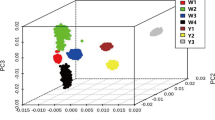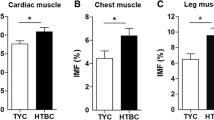Abstract
Myocyte-specific enhancer-binding factor 2A (MEF2A) gene is a member of the myocyte-specific enhancer-binding factor 2 (MEF2) protein family which involved in vertebrate skeletal muscle development and differentiation. The aim of the current study is to investigate the potential associations between MEF2A gene SNPs (single nucleotide polymorphisms) and the carcass traits in 471 chicken samples from four populations. Three new SNPs (T46023C, A72626G, and T89232G) were detected in the chicken MEF2A gene. The T46023C genotypes were associated with live body weight (BW), carcass weight (CW), eviscerated weight, semi-eviscerated weight (SEW), and leg muscle weight (LMW) (P < 0.05); the A72626G genotypes were associated with BW, CW, LMW (P < 0.01) and breast muscle weight (BMW), leg muscle percentage (LMP) (P < 0.05); whereas the T89232G genotypes were associated with carcass percentage (CP) and semi-eviscerated percentage (SEP) (P < 0.05). The haplotypes constructed on the three SNPs were associated with BW, CW, LMW (P < 0.01), SEW, BMW, CP (P < 0.05). Significantly and suggestive dominant effects of diplotype H1H2 were observed for BW, CW, SEW, BMW and CP, whereas diplotype H5H5 had a negative effect on BW, CW, SEW, BMW and LMW. Our results suggest that the MEF2A gene may be a potential marker affecting the muscle trait of chickens.
Similar content being viewed by others
References
Zhu MJ, Zhao SH (2007) Candidate gene identification approach: progress and challenges. Int J Biol Sci 3:420–427
Emara MG, Kim H (2003) Genetic markers and their application in poultry breeding. Poult Sci 82:952–957
Jiang R, Li J, Qu L, Li H, Yang N (2004) A new single nucleotide polymorphism in the chicken pituitary-specific transcription factor (POU1F1) gene associated with growth rate. Anim Genet 35:344–346
Li H, Deeb N, Zhou H, Ashwell CM, Lamont SJ (2005) Chicken quantitative trait loci for growth and body composition associated with the very low density apolipoprotein-II gene. Poult Sci 84:697–703
Zhou H, Mitchell AD, McMurtry JP, Ashwell CM, Lamont SJ (2005) Insulin-like growth factor-I gene polymorphism associations with growth, body composition, skeleton integrity, and metabolic traits in chickens. Poult Sci 84:212–219
Cao ZP, Wang SZ, Wang QG, Wang YX, Li H (2007) Association of Spot14alpha gene polymorphisms with body weight in the chicken. Poult Sci 86:1873–1880
Liu S, Wang SZ, Li ZH, Li H (2007) Association of single nucleotide polymorphism of chicken uncoupling protein gene with muscle and fatness traits. J Anim Breed Genet 124:230–235
Olson EN, Perry M, Schulz RA (1995) Regulation of muscle differentiation by the MEF2 family of MADS box transcription factors. Dev Biol 172:2–14
Yu YT, Breitbart RE, Smoot LB, Lee Y, Mahdavi V, Nadal-Ginard B (1992) Human myocyte-specific enhancer factor 2 comprises a group of tissue-restricted MADS box transcription factors. Genes Dev 6:1783–1798
Martin JF, Miano JM, Hustad CM, Copeland NG, Jenkins NA, Olson EN (1994) A Mef2 gene that generates a muscle-specific isoform via alternative mRNA splicing. Mol Cell Biol 14:1647–1656
Hobson GM, Krahe R, Garcia E, Siciliano MJ, Funanage VL (1995) Regional chromosomal assignments for four members of the MADS domain transcription enhancer factor 2 (MEF2) gene family to human chromosomes15q26, 19p12, 5q14, and 1q12–q23. BMC Genomics 29:704–711
Gossett LA, Kelvin DJ, Sternberg EA, Olson EN (1989) A new myocyte-specific enhancer-binding factor that recognizes a conserved element associated with multiple muscle-specific genes. Mol Cell Biol 9:5022–5033
Davis RL, Cheng PF, Lassar AB, Weintraub H (1990) The MyoD DNA binding domain contains a recognition code for muscle-specific gene activation. Cell 60:733–746
Morisaki T, Holmes EW (1993) Functionally distinct elements are required for expression of the AMPD1 gene in myocytes. Mol Cell Biol 13:5854–5860
Feo S, Antona V, Barbieri G, Passantino R, Cali L, Giallongo A (1995) Transcription of the human beta enolase gene (ENO-3) is regulated by an intronic muscle-specific enhancer that binds myocyte-specific enhancer factor 2 proteins nd ubiquitous G-rich-box binding factors. Mol Cell Biol 15:5991–6002
Rao MV, Donoghue MJ, Merlie JP, Sanes JR (1996) Distinct regulatory elements control muscle-specific, fiber-type-selective, and axially graded expression of a myosin lightchain gene in transgenic mice. Mol Cell Biol 16:3909–3922
Wang DZ, Valdez MR, McAnally J, Richardson J, Olson EN (2001) The Mef2c gene is a direct transcriptional target of myogenic bHLH and MEF2 proteins during skeletal muscle development. Development 128:4623–4633
Bour BA, O’Brien MA, Lockwood WL, Goldstein ES, Bodmer R, Taghert PH, Abmayr SM, Nguyen HT (1995) Drosophila MEF2, a transcription factor that is essential for myogenesis. Genes Dev 9:730–741
Lilly B, Zhao B, Ranganayakulu G, Paterson BM, Schulz RA, Olson EN (1995) Requirement of MADS domain transcription factor D-MEF2 for muscle formation in Drosophila. Science 267:688–693
Hinits Y, Hughes SM (2007) Mef2s are required for thick filament formation in nascent muscle fibres. Development 134:2511–2519
Molkentin JD, Black BL, Martin JF, Olson EN (1995) Cooperative activation of muscle gene expression by MEF2 and myogenic bHLH proteins. Cell 83:1125–1136
Spicer DB, Rhee J, Cheung WL, Lassar AB (1996) Inhibition of myogenic bHLH and MEF2 transcription factors by the bHLH protein Twist. Science 272:1476–1480
Ornatsky OI, Andreucci JJ, McDermott JC (1997) A dominant-negative form of transcription factor MEF2 inhibits myogenesis. J Biol Chem 272:33271–33278
Buchberger A, Arnold HH (1999) The MADS domain containing transcription factor cMef2a is expressed in heart and skeletal muscle during embryonic chick development. Dev Genes Evol 209:376–381
Wu H, Olson EN (2002) Activation of the MEF2 transcription factor in skeletal muscles from myotonic mice. J Clin Invest 109:1327–1333
L’honore A, Rana V, Arsic N, Franckhauser C, Lamb NJ, Fernandez A (2007) Identification of a new hybrid serum response factor and myocyte enhancer factor 2-binding element in MyoD enhancer required for MyoD expression during myogenesis. Mol Biol Cell 18:1992–2001
Potthoff MJ, Arnold MA, McAnally J, Richardson JA, Bassel-Duby R, Olson EN (2007) Regulation of skeletal muscle sarcomere integrity and postnatal muscle function by Mef2c. Mol Cell Biol 27:8143–8151
Potthoff MJ, Wu H, Arnold MA, Shelton JM, Backs J, McAnally J, Richardson JA, Bassel-Duby R, Olson EN (2007) Histone deacetylase degradation and MEF2 activation promote the formation of slow-twitch myofibers. J Clin Invest 117:2459–2467
Stephens M, Smith NJ, Donnelly P (2001) A new statistical method for haplotype reconstruction from population data. Am J Hum Genet 68:978–989
Li H, Deeb N, Zhou H, Mitchell AD, Ashwell CM, Lamont SJ (2003) Chicken quantitative trait loci for growth and body composition associated with transforming growth factor-ß genes. Poult Sci 82:347–356
Kaushal S, Schneider JW, Nadal-Ginard B, Mahdavi V (1994) Activation of the myogenic lineage by MEF2A, a factor that induces and cooperates with MyoD. Science 266:1236–1240
Musa HH, Chen GH, Cheng JH, Li BC, Mekki DM (2006) Study on carcass characteristics of chicken breeds raised under the intensive condition. Int J Poult Sci 5:530–533
Daly MJ, Rioux JD, Schaffner SF (2001) High-resolution haplotype structure in the human genome. Nat Genet 29:229–232
Zhang K, Calabrese P, Nordborg M, Sun F (2002) Haplotype block structure and its applications to association studies: power and study designs. Am J Hum Genet 71:1386–1394
Huang QQ, Fu YX, Boerwinkle E (2003) Comparison of strategies for selecting single nucleotide polymorphisms for case/control association studies. Hum Genet 113:253–257
Zhang WH, Collins A, Morton NE (2004) Does haplotype diversity predict power for association mapping of disease susceptibility. Hum Genet 115:157–164
Zhang K, Qin Z, Chen T, Liu JS, Waterman MS, Sun F (2005) HapBlock: haplotype block partitioning and tag SNP selection software using a set of dynamic programming algorithms. Bioinformatics 21:131–134
Acknowledgments
The authors gratefully acknowledge D. M. Shu, H. Qu, & C. F. Yang for help in managing the birds and collecting the data. The work was financially supported by the Chinese national key technologies R & D program (Grant No: 2008BADB2B01); the Province Key Technologies R & D Program of Livestock and Poultry Breeding Programs of Sichuan Province (No. 2006-YZGG-19 and 2006-YZGG-25); the Science Fund for Young Scholars in Sichuan Province (Grant No: ZQ 026-017); the National 863 Project of China (No. 2008AA101001) and the Open Fund of Sichuan Provincial Key Laboratory of Animal Breeding and Genetics, Sichuan Animal Science Academy.
Author information
Authors and Affiliations
Corresponding authors
Rights and permissions
About this article
Cite this article
Zhou, Y., Liu, Y., Jiang, X. et al. Polymorphism of chicken myocyte-specific enhancer-binding factor 2A gene and its association with chicken carcass traits. Mol Biol Rep 37, 587–594 (2010). https://doi.org/10.1007/s11033-009-9838-2
Received:
Accepted:
Published:
Issue Date:
DOI: https://doi.org/10.1007/s11033-009-9838-2




